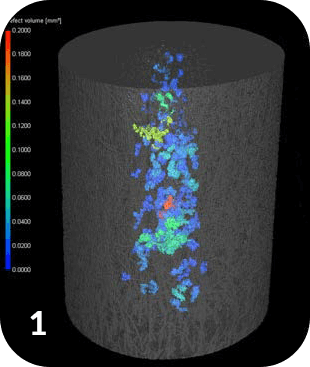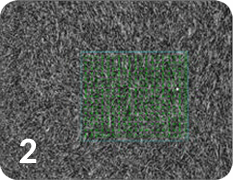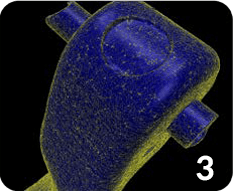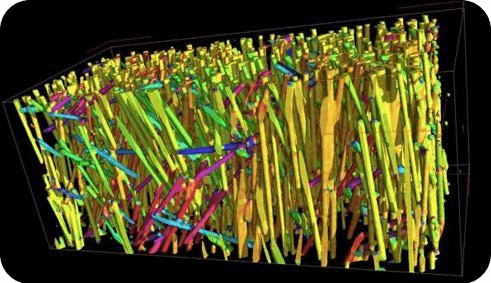Computed Tomography, the only non-destructive technology to see inside your samples!
Composite workpieces require many controls and inspections during the overall production process. Computed tomography (CT) is a powerful non-destructive technology to inspect every samples in an easy way and the only one giving the ability to see inside the matter.
3D visualization of the fiber distribution of a composite sample scanned by RX Solutions.

Computed tomography: Exploring composites components
Composites components are diverse and widely used in various industrial fields such as the aerospace, automotive or naval industries. They have complex material behavior displaying a range of failure modes.
Industrial CT scanning technology is the only inspection technique able to characterize in an easy way the overall material structure of a composite component. CT can provide precise measurements of the overall sample, from the whole structure down to individual fiber level. Every structural and dimensional aspect of composite parts can be assessed through one CT dataset.

Structural analyses: Quality control validation
Industrial CT scanning allows quick and accurate inspection of parts’ internal and external structures. With a resolution up to 5 μm, RX Solutions CT devices enable the validation of tiny details on composite components.
It is possible to define and export an accurate 3D model of the sample to make measurements of the inner and outer geometries, on simple or multi-material parts.




- Porosities into a compositecomponent
- Visualisation of the local fiber orientation inside a composite component
- Fiber analysis: Histogram representing the fiber orientation distribution
- STL representing the surface of a composite blade
Many different types of analyses can be performed using CT
CT datasets contain the entire sample geometric information and can be used to perform different kinds of analyses: voids analysis, actual parts to CAD comparison, part to part comparison, wall thickness analysis or reverse engineering.
Structural analyses: Fiber distribution, CAD vs CT comparison
Industrial CT scanning technology provides the possibility to quantify the fiber orientation and distribution inside your component. It gives important information, since the distribution affects the mechanical and physical properties of the workpiece, such as its strengths, internal stress or fatigue properties. Powerful analysis software enables to know if the fiber distribution is isotropic and homogeneous, by representing every fiber as a tensor.
Furthermore, a comparison between a CT dataset and a CAD nominal file can be made easily, to quickly and accurately compare the part to a CAD model, by showing the internal fibers deviations.
Defects analysis: Cracks, porosities, inclusions
Industrial CT scanning technology allows the identification of cracks, porosities or inclusions inside the scanned part. The volume fraction of pores and their spatial distribution in the sample can be calculated and highlighted with different colors using post-processing software.
RX Solutions CT scanners: Ease of use and automation
RX Solutions provides a software plugin called “CT wizard”: it makes RX Solutions DeskTom system very easy to operate, by adjusting automatically all CT settings. In addition, in a production line environment, an automation mode will dramatically reduce the cycle time for the control by setting all CT scan parameters automatically.
